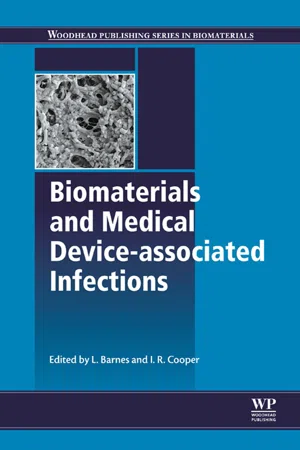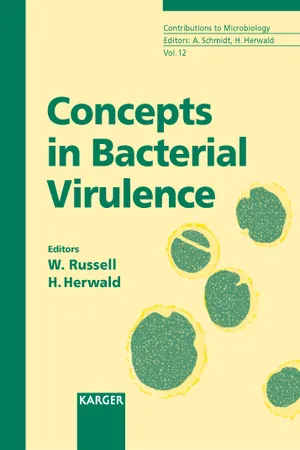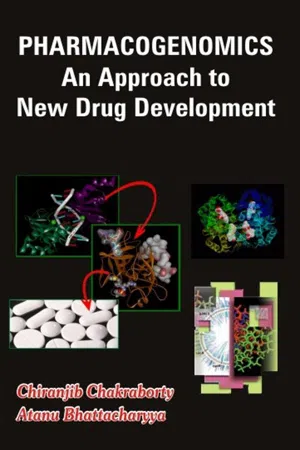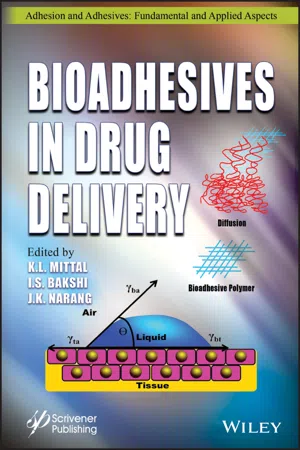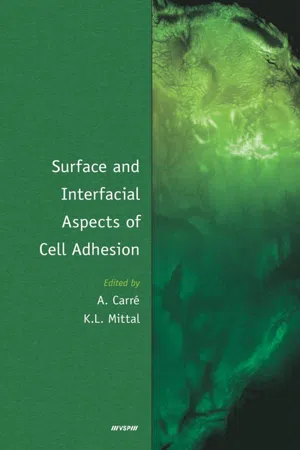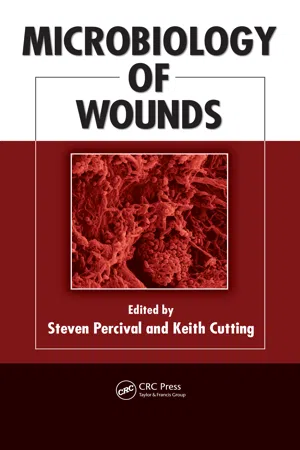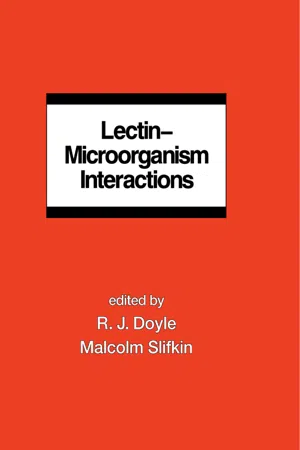Biological Sciences
Adhesins
Adhesins are surface proteins or molecules found in bacteria and other microorganisms that enable them to adhere to host cells or tissues. They play a crucial role in the initial stages of infection by facilitating the attachment of the pathogen to the host, which is a key step in the establishment of infection. Adhesins are important targets for developing strategies to prevent and treat infections.
Written by Perlego with AI-assistance
Related key terms
1 of 5
9 Key excerpts on "Adhesins"
- L Barnes, Ian Cooper(Authors)
- 2014(Publication Date)
- Woodhead Publishing(Publisher)
They are of greater importance in irreversible attachment as they often contain specific molecular Adhesins for attachment to binding sites on the implant surface. Adhesins are cell-surface components that facilitate bacterial adhesion, promoting adherence to other bacterial cells or to inert surfaces such as biomaterials (Darouiche, 2001). For Adhesins to serve their purpose and form molecular interactions with surfaces they must be exposed, so peripheral structures such as fimbriae are perfect for this role (Jones et al., 1995). Protein based Adhesins may also be anchored to the cell wall or cytoplasmic membrane. Adhesins are important in the irreversible process of secondary microbial adhesion which involves specific molecular and cellular interactions. Adhesins bind to specific binding sites present on the implant surface, conditioning film and/or tissue and are also defined for certain microbial species (Hancock et al., 2011). They may react with inorganic substratum elements non-specifically, through hydrophobic or electrostatic interactions. By making contact with the conditioning layer these appendages indirectly aid in consolidating the microbial-surface bonds via chemical hydration and oxidation reactions (Kumar and Anand, 1998). The presence of Adhesins is controlled at a genetic level by the up and down regulation of associated genes. Of great significance is the observation that different species of microorganisms can induce the transcription of specific Adhesins and promote adherence of other species (Merritt and An, 2000)- eBook - PDF
- W. Russell, H. Herwald, A. Schmidt, H. Herwald(Authors)
- 2004(Publication Date)
- S. Karger(Publisher)
Russell W, Herwald H (eds): Concepts in Bacterial Virulence. Contrib Microbiol. Basel, Karger, 2004, vol 12, pp 90–113 Gram-Positive Adhesins Susanne R. Talay GBF-German Research Centre for Biotechnology, Braunschweig, Germany In the process of bacterial infection, adhesion to host tissues represents an initial and essential step. Adhesion allows the pathogen to attach to and colonize specific sites of the body, thereby withstanding eradication through cleansing mechanisms such as excretion and peristalsis. Once attached to the target tissue, bacteria may either remain extracellular, multiply, and eventually spread into deeper tissue, or trigger their own uptake by host cells, resulting in an intra-cellular location that may allow the pathogen to persist or further spread within the cellular or subcellular compartment. Bacterial surface components that mediate adherence are called Adhesins. Among gram-positive pathogens, surface proteins represent the largest group of Adhesins, although other factors such as polysaccharides and lipids may also display adhesive functions. Targets for these microbial Adhesins are host mole-cules found on mucosal surfaces, skin, and wounds. Depending on the strength of this interaction, Adhesins allow the pathogen to loosely associate with or intimately bind to specific cells or tissues. Most gram-positive pathogens express multiple Adhesins that may bind to either the same or distinct target molecules. Multiple Adhesins of one pathogen are likely to be involved in different stages of an infection, expressed under different environmentally determined condi-tions, and may display a redundant function. In the present article, Adhesins of pathogenic gram-positive bacteria belonging to the genus Streptococcus , Staphylococcus and Listeria , as well as the most important host molecules targeted by these Adhesins are reviewed. - Chakraborty, Chiranjib(Authors)
- 2021(Publication Date)
- Biotech(Publisher)
CHAPTER 5 BACTERIAL Adhesins-BASED SURFACE PROTEIN Today Targets for New Vaccine Development Introduction Blocking the primary infection (mainly bacterial attachment to host cell receptors and colonization of the mucosal surface) may be the most effective strategy to prevent bacterial infections. Bacterial attachment involves through an interaction between a bacterial surface protein (adhesin) and the host cell receptor. Recent vaccine studies with adhesin have confirmed that antibodies elicited against an adhesin can impede colonization, block infection, and prevent disease. The chapter reviews the adhesin types in both from the gram positive and gram negative bacteria and the prophylactic vaccination with Adhesins that can block bacterial infections. The Principal aim of new vaccine development is to produce long-term protective immune responses against a pathogen. These responses include systemic humoral antibodies that neutralize in vasive organisms and cytotoxic T cells, which are required to clear certain infections, particularly chronic viral infections such as HIV (1). Helper T-cell and cytokine responses also influence humoral and cellular immune responses (2). For most bacteria and viruses, the first encounter with their host invloves attachment to a eukaryotic cell surface, which results the colonization of the host prior to disease. In such cases, induced antibody responses at the mucosal surface could prevent attachment and colonization. The ideal target for such antibodies surface proteins known as Adhesins – mediate microbial attachment to host tissue (3). Studies with adhesin, the FimH protein from Escherichia coli , show that anti-adhesin antibodies can block microbial attachment and subsequent disease. This ebook is exclusively for this university only. Cannot be resold/distributed. Furthermore, while specific induction of immune responses along the mucosal surface by mucosal immunization may have its advantages (4-7).- OECD(Author)
- 2016(Publication Date)
- OECD(Publisher)
When the hybrid proteins were expressed in E. coli , the cells acquired novel adherence traits resulting in the self-association and clumping of planktonic bacteria in liquid media, or in formation of stable consortia between cells of strains expressing the dimerisation domains. Another type of adherence is bacterial attachment to a surface and each other to form a biofilm. In a biofilm the adherence is mediated by an extracellular polysaccharide slime that acts as a kind of non-specific (although the signal to produce the biofilm may be specific) glue to bind the bacteria to each other and to a surface (Watnick and Kolter, 2000; Salyers and Whitt, 2002). Many microbes can occupy a variety of habitats whereas others are confined to a specific microenvironment. The range of hosts, tissues or cell types colonised by bacteria is determined, in part, by adhesin recognition of and affinity for host receptors. For example, most Bordetella spp. can cause a similar disease in the upper respiratory tract of many mammals but their host specificities can differ considerably. B. pertussis is human specific while B. bronchisepta is responsible for infecting a wide variety of mammals and birds but only rarely causes disease in humans. Strains of B. parapertussis can be divided into two groups, one which is human specific, the other ovine specific (Cummings et al., 2004). Host invasion Subsequent to attachment, the bacterium may or may not invade the host, depending upon the pathogen. In any case, the host-associated pathogen must now repel the host defenses. Infection is the invasion of the host by micro-organisms, which then multiply in close association with the host’s tissues. Mechanisms that enable a bacterium to invade eukaryotic cells make entry possible at mucosal surfaces. Whereas some invasive bacteria are obligate intracellular pathogens, most are facultative intracellular pathogens.- eBook - ePub
- K. L. Mittal, Inderbir Singh Bakshi, Jasjit Kaur Narang, K. L. Mittal, Inderbir Singh Bakshi, Jasjit Kaur Narang, K. L. Mittal, Inderbir Singh Bakshi, Jasjit Kaur Narang(Authors)
- 2020(Publication Date)
- Wiley-Scrivener(Publisher)
The bond between two materials is governed by interfacial forces. Bioadhesion is quite similar to the conventional adhesion process [ 1 ]. The only difference is that bioadhesion involves special characteristics of biological organisms and surfaces. The phenomenon of bioadhesion can be classified into specific and non-specific bioadhesion [ 2 ]. The specific bioadhesion invloves mostly polymers or some biological molecules that allow the bioadhesion at cell surface or mucus. For example, lectins, the carbohydrate binding proteins derived from plant sources, have the ability to recognize a particular type of sugar molecule(s) and adhere to it. The adhesion of bacteria to the human gut may be attributed to the interaction of a lectin-like structure (present on the bacterial cell surface) and mucin. The adhering property of the lectins to the cell surface is remarkable and thus these are known to be bioadhesive. Tomato lectin is a good example of a specific bioadhesive. Tomato lectin is a complex glycoprotein that can specifically adhere to the short arrays of N-acetylglucosamine [ 3 ]. Bacterial Adhesins, fimbrin, wheat germ (Phaseolus vulgaris) agglutinin, etc. are some other specific bioadhesive lectins. The non-specific bioadhesive molecules (polycarbophil, chitosan, carbopol, and carbomers) have the ability to bind with both the cell surface and the mucosal layer [ 4 ]. The property of bioadhesion has also been observed in the group of marine animals known as ascidians. The development of bioadhesives inspired from marine animals is a promising approach to generate new tissue-compatible medical components like non-fouling surfaces. 1.1.1 Historical Perspective The use of mucoadhesive polymers for the development of pharmaceutical formulations was reported back in 1947, when attempts were made to develop a mucosal drug delivery of penicillin using gum tragacanth and dental adhesive powders [ 5, 6 ] - eBook - ePub
- Jiri Mestecky, Michael E. Lamm, Pearay L. Ogra, Warren Strober, John Bienenstock, Jerry R. McGhee, Lloyd Mayer(Authors)
- 2005(Publication Date)
- Academic Press(Publisher)
Chapter 3 Adhesion of Bacteria to Mucosal SurfacesSoman N. Abraham Departments of Pathology and Molecular Genetics and Microbiology, Duke University, Medical Center, Durham, North CarolinaBrian L. Bishop Department of Molecular Genetics and Microbiology, Duke University Medical Center, Durham, North CarolinaNathan Sharon Department of Membrane Research and Biophysics, Weizmann Institute of Science, Rehovot, IsraelItzhak Ofek Department of Human Microbiology, Sackler Faculty of Medicine, Tel-Aviv, University, Tel-Aviv, IsraelINTRODUCTION
An overwhelming number of infectious diseases are initiated by bacterial colonization of the mucosal surfaces of the genitourinary, gastrointestinal, or respiratory tracts. Since mucosal colonization by bacteria is preceded by bacterial attachment to epithelial cells or to mucins coating these mucosal cells, intensive studies have focused on the cellular and molecular aspects underlying the adhesion of bacteria. These studies have revealed that many bacteria express on their surfaces, frequently in the form of specialized organelles, Adhesins that seek and bind to cognate receptors on the surface of mucosal cells. The specific binding interaction between the bacterial Adhesins and host receptors allows the bacteria to firmly attach to particular sites on the mucosal surfaces and thereby resist dislocation by the hydrokinetic forces that typically act on these surfaces.Although adhesion of bacteria to mucosal surfaces is an important determinant of mucosal colonization, especially in determining its site and density, it is becoming increasingly clear that this is not the complete story. Several critical postadhesion events are necessary for the bacteria to successfully establish themselves on the mucosal surfaces and to initiate infection. These events, triggered by the adhesion of the bacteria to their complementary receptor on the mucosal cells, include alterations to the expression of virulence factors by the bacteria on one hand and induction of physiologic changes on the mucosal surface. The latter include proliferation of epithelial cells, increased mucus secretion, endocytosis of adherent bacteria, and release of proinflammatory and antiinflammatory mediators by mucosal and submucosal cells. This chapter briefly reviews the current state of knowledge of bacterial Adhesins and their mucosal cell receptors. It then discusses selected postadhesion events and describes how they influence mucosal colonization. Finally, it shows how the knowledge gained provides a basis for the development of antiadhesion agents that can block and even reverse bacterial colonization of mucosal surfaces and their harmful postadhesive events. - Alain Carre, Kash L. Mittal(Authors)
- 2011(Publication Date)
- CRC Press(Publisher)
Depending on the species and strain, lectins are located in the bacterial cell wall or on the tip of pili, which is, for example, the case of the mannose-specific adhesin of E. coli (FimH) [26]. In general, lectins are an impor-tant class of Adhesins that are involved in many infections of animal tissues. They have been described in numbers of pathogenic bacteria [133]. In P. aeruginosa , for example, they are an essential tool of bacterial cells for binding to the carbohydrate residues present at the surface of the host tissue (lungs of cystic fibrosis patients, for example) before further host tissue colonisation [131]. They are also essential for uropathogenic E. coli to bind to the bladder epithelium cells [134]. 4.1.4. Other Proteins Other non-fimbriae proteins, known as autotransporters, have been reported for their adhesin function. Antigen 43 (Ag43), for example, has been shown to me-diate bacterial autoaggregation through Ag43–Ag43 interactions [135]. 4.1.5. Polysaccharides Aside from proteins, some polysaccharides play an adhesive role in bacterial ad-hesion. This is the case of the lipopolysaccharides (LPS) which are carbohydrate macromolecules present in large numbers in the outer membrane of Gram-negative bacteria. Modifications in the structure of LPS have been shown to significantly af-fect the rate of bacteria deposition and further attachment [136, 137]. AFM force measurements supported this assertion, showing that intact LPS were necessary to obtain strong adhesion between bacteria and surfaces [21]. However, whether LPS impacted bacteria-to-surface contact was not clearly elucidated. The role of the charges conferred on the whole bacterium by the various LPS structures has been 86 L. Ploux et al. / Surface and Interfacial Aspects of Cell Adhesion (2010) 65–101 implicated, but no correlation with the length of LPS was shown.- eBook - PDF
- Steven Percival, Keith Cutting(Authors)
- 2010(Publication Date)
- CRC Press(Publisher)
This negative charge will reduce bacterial attachment to a negatively charged sur-face. In aqueous environments, most surfaces have been reported to be negatively charged. 59 In biological systems, the distribution of ions is more complex and in a state of flux. There is a constant battle between the host’s immune system and bacteria to attach to a surface. Bacteria have many strategies to evade the host’s immune system. If the host is compromised, it becomes colonized by an array of different “commensal” microorganisms that form biofilms. Once bacteria have secured a habitable environ-ment in the body, they possess many mechanisms to ensure they remain attached. Bacteria possess proteins on their surface to bind to the host’s extracellular matrix, such as fibronectin, fibrinogen, vitronectin, and elastin. These are referred to as MSCRAMMs (microbial surface component recognizing adhesive matrix molecules) and are known to be significant to microbial adhesion to the host. 60 Role of Pili and Fimbriae in Adhesion Many interactions between bacteria and surfaces have been observed to be stereo-specific. The bacterial surface-associated molecules that aid stereospecific adhesion of bacteria are referred to as Adhesins. Adhesins are located on bacterial appendages such as flagella, capsules, fimbriae, and outer membranes. 61 These Adhesins promote bacterial adhesion to a surface by bridging the gap between the bacterium and the repulsive electrostatic forces, which aid to repel bacteria. 28 Microbiology of Wounds O’Toole and Kolter 55 demonstrated that mutants of Pseudomonas aeruginosa required type IV pili-mediated twitching motility to enable aggregation at a sur-face. Twitching motility is thought to aid the migration of bacteria across a surface, enabling coaggregation, and therefore enhance coadhesion and enhance survival. 62 Fimbriae play a role in cell surface hydrophobicity and attachment of bacteria to a surface. - eBook - PDF
- R. Doyle(Author)
- 1994(Publication Date)
- CRC Press(Publisher)
FEMS Microbiol Lett 1989; 47:331-340. 15. Old DC. Bacterial cell envelopes in adhesion. In: Hancock I, Poxton I, eds. Bacterial cell surface techniques. Chichester: John Wiley & Sons, 1988:227-240. 16. Ofek I. Lectinophagocytosis mediated by bacterial surface lectins. Zentralbl Bakteriol Hyg [A1] 1989; 270:449-455. 17. Karlsson KA. Animal glycosphingolipids as membrane attachment sites for bacteria. Annu Rev Biochem 1989; 58:309-350. 18. Mirelman D, ed. Microbiallectins and agglutinins: properties and biological activity. New York: John Wiley & Sons, 1986. 19. Sharon N. The lectins. In: Liener IE, Sharon N, Goldstein IJ, eds. Lectins: properties, functions and applications in biology and medicine. Orlando: Academic Press, 1986. 20. Uhlenbruck G. Bacteriallectins: mediators of adhesion. Zentralbl Bakteriol Hyg [A] 1987; 263:497-508. 21. Gilboa-Garber N, Garber N. Microbiallectins. In: Allen HJ, Kisailus EC, eds. Handbook of glycoprotein&. New York: Marcel Dekker, 1989. 22. Nimich W. Adhesins of Escherichia coli. Acta Biotechnol1990; 10:151-161. 23. Markwell MAK. Viruses as hemagglutinin& and lectins. In: Mirelman D, ed. Microbiallectins and agglutinins. New York: John Wiley & Sons, 1986:21-53. 24. Wollin R, Bruse OW, Jansson P, Lindberg S. Definition of the phage 013 receptor as structural domains of trisaccharide& in Salmonella and Esche-richia coli core oligosaccharide&. J Mol Recogn 1989; 2:37-43. 25. Norberg T, Ritzen H. Synthesis of methyl a-o-glycopyranosyl-(1-2)-a-D-galactopyranosyl acyclic analogue thereof for probing the carbohydrate-binding specificity of bacteriophage t/>X174. Glycoconjugate J 1986; 3:135-142. 26. Schultze B, Gross HJ, Brossmer R, Klenk HD, Herrber G. Hemagglutinating encephalomyelitis virus attaches to N-acetyl-9-0-acetylneuraminic acid-containing receptors on erythrocytes: comparison with bovine coronavirus and influenza C virus. Virus Res 1990; 16:185-194. 27. Komai K, Kaplan M, Peeples ME.
Index pages curate the most relevant extracts from our library of academic textbooks. They’ve been created using an in-house natural language model (NLM), each adding context and meaning to key research topics.
